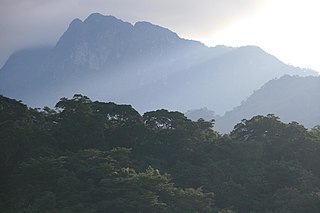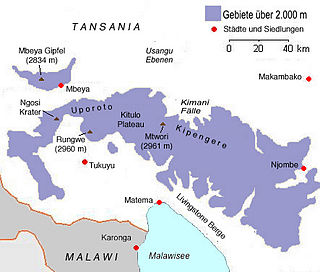Related Research Articles

Fischer's chameleon, also known commonly as the Nguru blade-horned chameleon and the Nguru two-horned chameleon, is a species of chameleon, a lizard in the family Chamaeleonidae. The species is endemic to Tanzania.
The Mahenge Mountains are a mountain range in Ulanga District, Morogoro Region, Tanzania. The town of Mahenge is located in the northeastern mountains. The mountains are southeast of Iringa, in the Eastern miombo woodlands ecoregion.
The Nguru Mountains are a mountain range in Morogoro Region, Tanzania, Africa. They are part of the Eastern Arc Mountains. The mountains are predominantly covered with rainforest, home to 83 species of birds and African violets. Several forest reserves are located in the mountains.

Callulina is a small genus of frogs in the family Brevicipitidae with nine members in Tanzania and Kenya. Originally Callulina was thought to be monotypic and widely distributed through Eastern Arc Mountains in Tanzania and in southern Kenya. However, within the last decade eight new species has been identified, the majority of which are considered critically endangered by the International Union for Conservation of Nature (IUCN).

The Udzungwa Mountains are a mountain range in south-central Tanzania. The mountains are mostly within Iringa Region, south of Tanzania's capital Dodoma. The Udzungwa Mountains are part of the Eastern Arc Mountains, and are home to a biodiverse community of flora and fauna with large numbers of endemic species.

The Usambara Mountains of northeastern Tanzania in tropical East Africa, comprise the easternmost ranges of the Eastern Arc Mountains. The ranges of approximately 90 kilometres (56 mi) long and about half that wide, are situated in the Lushoto District of the Tanga Region. They were formed nearly two million years ago by faulting and uplifting, and are composed of Precambrian metamorphic rocks. They are split into two sub-ranges; the West Usambaras being higher than the East Usambaras, which are nearer the coast and receive more rainfall.

Mount Rungwe is a volcanic mountain in Mbeya Region, in Tanzania's Southern Highlands. At an altitude of 2,981 metres (9,780 ft), it is southern Tanzania's second-highest peak. Rungwe's volcano is currently inactive.

The Coastal forests of eastern Africa, also known as the East African Coastal Forests or Zanzibar–Inhambane forests, is a tropical moist forest region along the east coast of Africa. The region was designated a biodiversity hotspot by Conservation International.
The Uluguru mountains are a mountain range in eastern Tanzania, named after the Luguru tribe. The main portion of the Uluguru mountains is a ridge running roughly north-south and rising to 2,630 metres (8,600 ft) altitude at its highest point. On the main Uluguru range, 50 villages touch the forest boundary and over 151,000 people are found within the mountain area, often at increasing densities at higher altitudes up to the forest boundary.

The Eastern Arc Mountains are a chain of mountains found in Kenya and Tanzania. The chain runs from northeast to southwest, with the Taita Hills being in Kenya and the other ranges being in Tanzania. They are delimited on the southwest by the fault complex represented by the Makambako Gap that separates them from the Kipengere Range. To the northeast, they are delimited by more recent volcanism represented by Mount Kilimanjaro. The chain is considered a tentative World Heritage Site.
Zenkerella perplexa is a species of plant in the family Fabaceae. It is found only in Tanzania, where it is endemic to the Eastern Arc forests.

The Wami River is a river located in Pwani Region, Tanzania. The headwaters of the Wami and its tributaries originate in the Eastern Arc Mountains of Morogoro Region. The river then flows northeastward through of Pwani Region to empty into the Indian Ocean west of Zanzibar Island.

The East African montane forests is a montane tropical moist forest ecoregion of eastern Africa. The ecoregion comprises several separate areas above 2000 meters in the mountains of South Sudan, Uganda, Kenya, and Tanzania.
Abisara delicata, the delicate Judy is a butterfly in the family Riodinidae. It is found in Tanzania and Malawi.

Northern Zanzibar–Inhambane coastal forest mosaic, also known as the Northern Swahili coastal forests and woodlands, is a tropical moist broadleaf forest ecoregion of coastal East Africa. The ecoregion includes a variety of habitats, including forest, savanna and swamps.

The Eastern Arc forests is a montane tropical moist forest ecoregion of eastern Africa. The ecoregion comprises several separate highland areas above 800 meters in Kenya, and (mostly) Tanzania.
The Rubeho Mountains are a mountain range in central Tanzania. The mountains in Dodoma and Morogoro regions, southeast of Tanzania's capital Dodoma. The Rubeho Mountains are part of the Eastern Arc Mountains, and are home to a biodiverse community of flora and fauna with large numbers of endemic species.
The Ukaguru Mountains are a mountain range in central Tanzania. The mountains are in Morogoro region, east of Tanzania's capital Dodoma. The mountains are named for the Kaguru people. The Ukaguru Mountains are part of the Eastern Arc Mountains, and are home to a biodiverse community of flora and fauna with large numbers of endemic species.
The Uvidunda Mountains are a mountain range in Tanzania's [[Morogoro Region] Kilosa district, Mikumi division].The Mountains named afterVidunda tribe small tribe dwell on Mountains.Uvidunda Mountains located with more than 6 untouched waterfalls trail.The Uvidunda Mountains Cultural Tourism Enterprise initiated by conservation tourism enterprise Mikumi Eco & Cultural Tourism is the one develop and manage Chizua Waterfalls,Kigaga Waterfalls, Mzombe waterfall,Mululu waterfalls, Ibwedunghu waterfall,Makene Ngoroma Trail and Uvidunda Zipline.People living on Uvidunda Mountains are known as WaVidunda,their language is Chividunda.
Malundwe Mountain, also known as Malundwe Hill, is a mountain in Tanzania. It is located in Mikumi National Park in Morogoro Region.
References
- ↑ N. D. Burgess et al. (2007). "The biological importance of the Eastern Arc Mountains of Tanzania and Kenya". Biological Conservation 134 (2007) pp. 209–231.
- ↑ "Nguu". Eastern Arc Mountains Conservation Endowment Fund. Accessed 20 September 2019.
- ↑ "Eastern Arc forests". World Wildlife Fund ecoregion profile. Accessed 10 September 2019.
- ↑ "Eastern Arc forests". World Wildlife Fund ecoregion profile. Accessed 10 September 2019.
- ↑ Briggs, Philip (2009). Northern Tanzania: The Bradt Safari Guide with Kilimanjaro and Zanzibar. Bradt Travel Guides. pp. 20–21. ISBN 978-1-84162-292-7.
- ↑ Newmark, W. D., 2002, Conserving Biodiversity in East African Forests, a Study of the Eastern Arc Mountains. Ecological Studies 155. Springer-Verlag, Berlin, pp. 197
- ↑ N. D. Burgess et al. (2007). "The biological importance of the Eastern Arc Mountains of Tanzania and Kenya". Biological Conservation 134 (2007) pp. 209–231
- ↑ "Nguu". Eastern Arc Mountains Conservation Endowment Fund. Accessed 20 September 2019.
- ↑ N. D. Burgess et al. (2007). "The biological importance of the Eastern Arc Mountains of Tanzania and Kenya". Biological Conservation 134 (2007) pp. 209–231
- ↑ "Nguu". Eastern Arc Mountains Conservation Endowment Fund. Accessed 20 September 2019.
- ↑ "Nguu". Eastern Arc Mountains Conservation Endowment Fund. Accessed 20 September 2019.
- ↑ N. D. Burgess et al. (2007). "The biological importance of the Eastern Arc Mountains of Tanzania and Kenya". Biological Conservation 134 (2007) pp. 209–231
- ↑ BirdLife International (2019) Important Bird Areas factsheet: Nguu Mountains. Downloaded from http://www.birdlife.org on 22/09/2019.